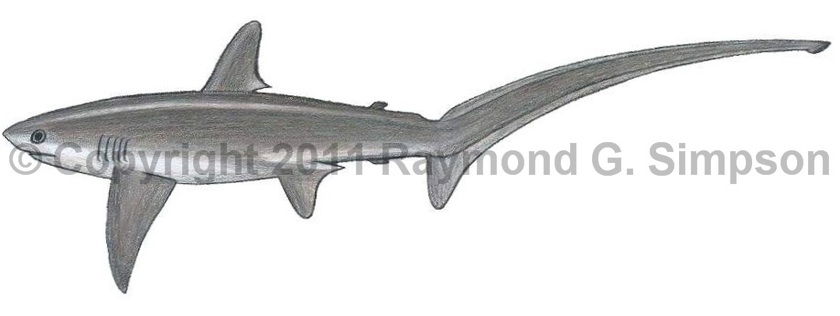
Common Name
Common Thresher
Year Described
Bonnaterre, 1788
Identification
Elongate and fusiform, with an extremely long upper caudal lobe. Head very small, with a moderate sized eye and a long snout. Top of head convex. There are no grooves on the head posterior to the eyes. Labial furrows present. Teeth number 20/20 upper rows and 21/21 lower rows. Teeth are small with angled triangular cusps; similar in both jaws. Dorsal fin quite high with the origin about midway between pectoral and pelvic fin. Pectoral fin large and pointed. Second dorsal and anal fins tiny. Pelvic fin abdominal and quite large. Dermal denticles dense and overlapping, with 3-5 points and 3 ridges.
Color
Dark gray to black above, changing to gray on the flanks, and abruptly white on the belly. The demarcation between dark and white coloration is irregular. A strong metallic purple or blue sheen in fresh specimens. Fins the color of the dorsum.
Size
Maximum size to over 550cm TL, but most individuals under 400cm TL. Newborns at around 140-150cm TL.
Habitat
Pelagic, from close to shore to open ocean (0-366m). It is more common in cooler waters and is rare or a vagrant to tropical seas. Threshers use their tails to stun fishes.
Range
Newfoundland to S. Florida, and Venezuela to Argentina. Quite rare in the Caribbean and Gulf of Mexico and these might be winter vagrants.
References
Castro, J.I. 2011. The Sharks of North America. Oxford University Press, 640 pp.
Compagno, L.J.V. 2002. Sharks. In: Carpenter, K.E. (Editor) FAO Identification Guide for Fishery Purposes. The Living Marine Resources of The Western Central Atlantic. Volume 1: Introduction, mollusks, crustaceans, hagfishes, sharks, batoid fishes, and chimaeras. ASIH Special Publication No. 5. FAO, Rome.
Compagno, L., M. Dando, and S. Fowler. 2005. Sharks of the World. Princeton University Press, 480 pp.